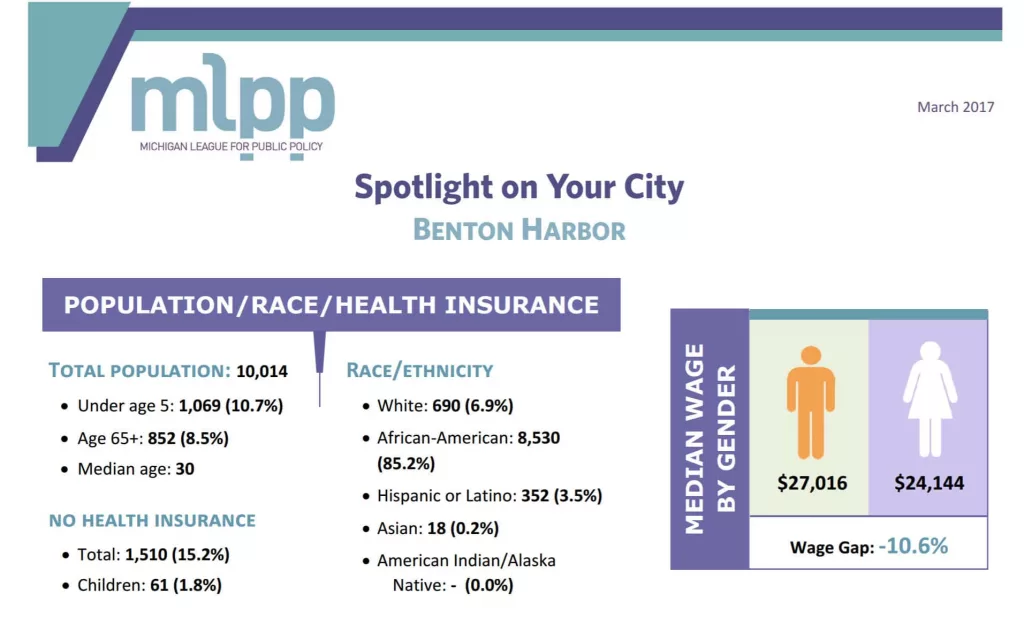On this observance of Equal Pay Day in America, women are being reminded everywhere that there is still no such thing, as the disparity continues at a rate that, if left unchecked, would not see women achieve pay equality until the year 2152. Highly unlikely that anyone alive today will be around to see that “achievement.”
Thanks to the Michigan League for Public Policy we can provide a few statistics regarding Michigan and even down to the local level in Benton Harbor. The good news is there is more equal pay for women in Benton Harbor than there is in either Holland or Ann Arbor, and the situation is considerably better locally than the statewide median pay rate.
In the big picture, the League reports that Michigan’s income inequality is a persistent and increasing problem that has a negative impact on the state’s residents and economy. Between 1947 and 1979, incomes at all levels increased at relatively similar rates for Michigan residents as well as nationally. In the late 1970s, there was a significant divergence as most of the income growth started going to the top earners and leaving the rest of Michigan residents behind. Essentially, Michigan’s top 1-percent makes 22 times more than the rest of the workers in the state.
Over the ensuing 30-plus years, Michigan incomes fared worse than most of the rest of the nation. Between 1979 and 2013, overall incomes actually fell in the state. However, income decline in the bottom 99-percent solely caused that decline. In 1979, the top 1-percent of Michigan households held about 9-percent of the total income in the state. By 2013, the share of state income taken home by that group had nearly doubled to 17.9-percent, while the rest of Michigan residents saw their incomes decline.
The League for Public Policy says that major income disparities exist between different genders and races, as well. In 2014, Michigan women working full time still made only 74.6 cents for every $1 a full-time working male made. That is below the national average and ranks Michigan as one of the worst states in the Midwest region, trailing all of our immediate neighbors. In addition, women of color, and most men of color, continue to have lower median incomes than white, full-time working men.
The League has compiled a variety of data on Michigan’s counties, legislative districts and select cities, including local data on the gender wage gap that they are sharing here on Equal Pay Day. The observance of Equal Pay Day symbolizes how far into the year women must work to earn what men earned in the previous year.
The Michigan League for Public Policy has been actively fighting for income equality for all people, especially women and people of color. They argue that “Our families, our businesses, our communities and our economy are all hurt by the gender wage gap, and the League will keep working to change public policy to address it.”
As shown in the illustration accompanying this story on Moody on the Market.com, provided by the Michigan League for Public Policy, Benton Harbor’s wage gap sits at -10.6-percent with the median male wage at $27,016 while Benton Harbor women earn $24,144 for the same work. Nevertheless, that’s a better performance than the 21st Senatorial District here in the region where the gap sits at -27.3-percent and the Berrien County wage gap looms higher still at -28-percent. Countywide the median wage for men is $47,463 while women earn $34,277 for the same work.
Cass County’s wage gap is -23-percent with the men’s median wage at $42,852 and women sit at $33,145. Van Buren County scores two percentage points better with a wage gap of -21-percent based on men’s median pay of $46,055 and women’s median wages at $36,501.
For the entire state of Michigan, men’s median wages are $50,924 while women score only $38,114 for the same work, representing a -24.7-percent wage gap.
While Ann Arbor’s overall wages are higher, the gap sits at -16.5-percent there with men earning $61,458 at the median while women draw $51,339 for the same work.
Detroit’s wage gap is -9-percent with men earning a median wage of $33,924 while women clock in at $30,856.
Grand Rapids has a smaller gap at -8.6-percent with slightly higher median wages at $38,392 for men and $35,101 for women in the same time. Kalamazoo is closer to the Benton Harbor gap at -10.3-percent with men taking home a media wage rate of $35,697 while women earn $32,035 in the same time frame.
Holland’s gap sits at -17.7-percent based on men’s median wages of $41,433 and women’s median rate at $34,082.
If you want to find the narrowest gap, you’ll have to head to the extreme opposite end of the state, way up in the Upper Peninsula’s Keweenaw County where the gap is -5-percent based on median male wages of $39,000 and women’s earnings of $36,944.
Across the nation, women are paid 80-cents for every $1 paid to men in the same full-time work.
Member of Congress have announced steps to close the pay gap by introducing vital legislation, including the Paycheck Fairness Act. Stay tuned.
The Michigan League for Public Policy did not survey every community in the state, and Benton Harbor was the only one in the tri-county area to be measured specifically in this study.






